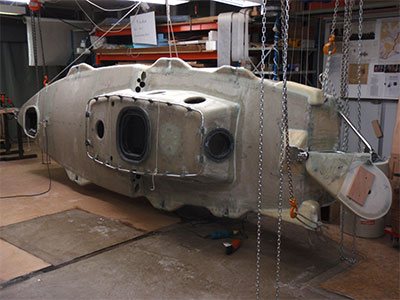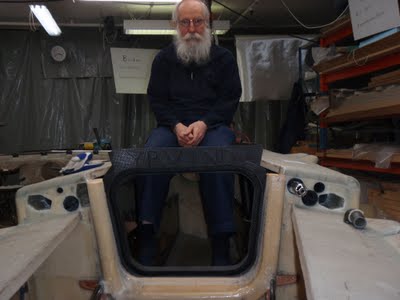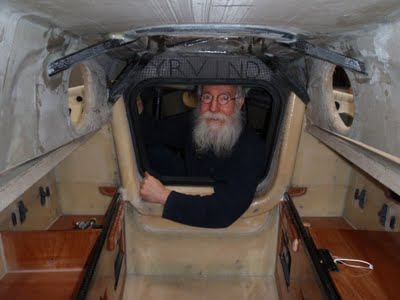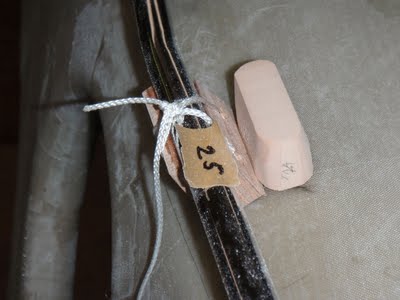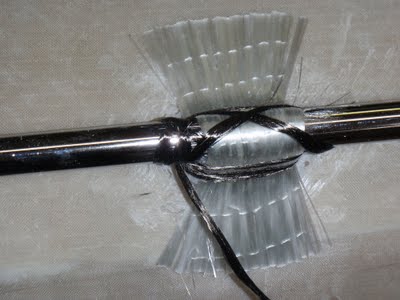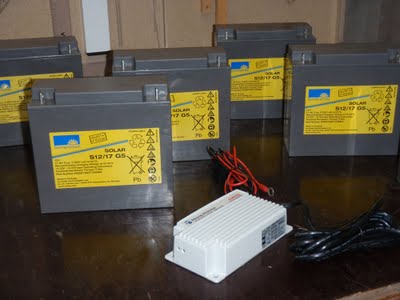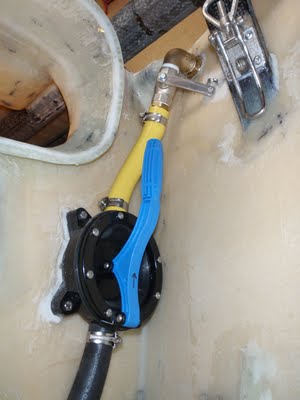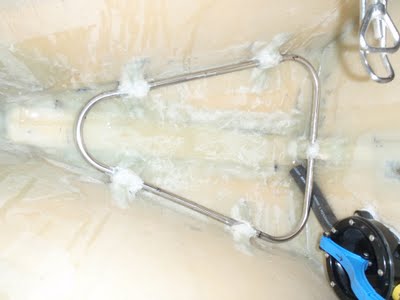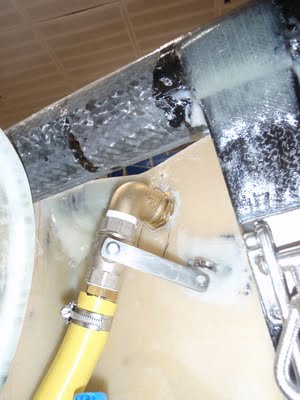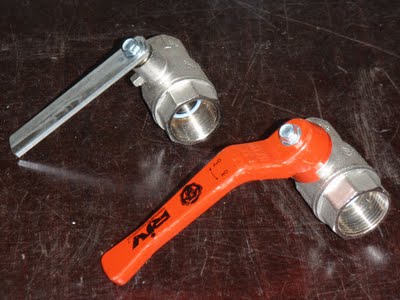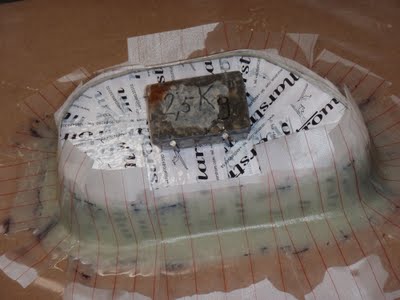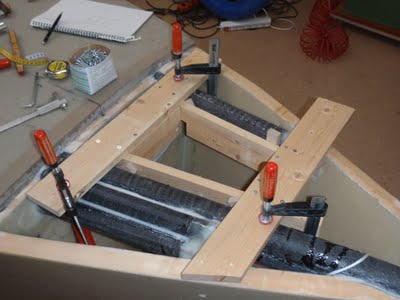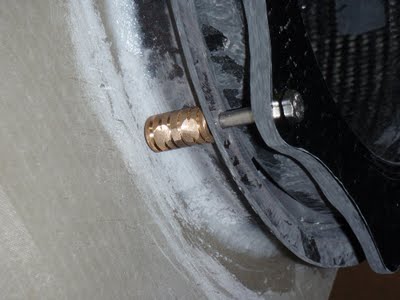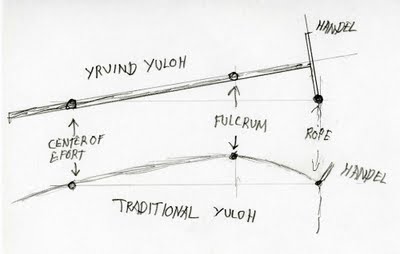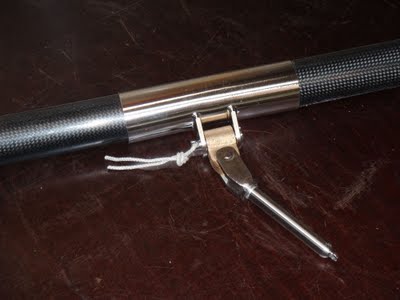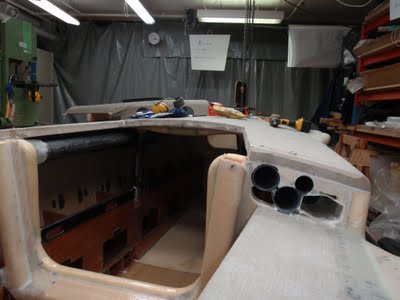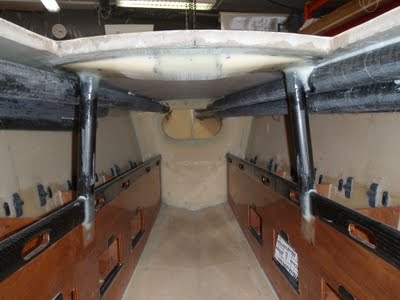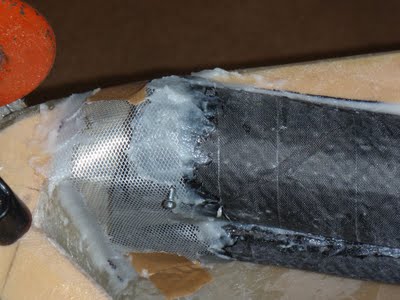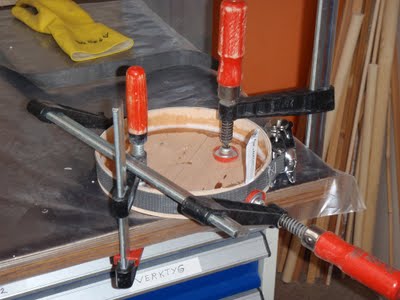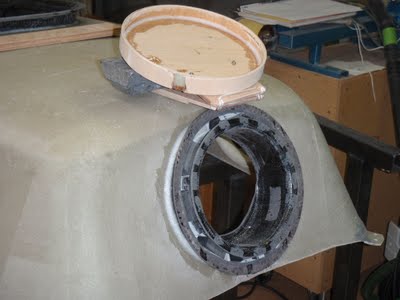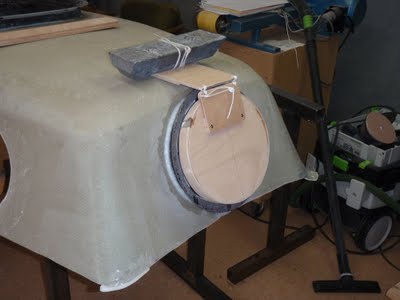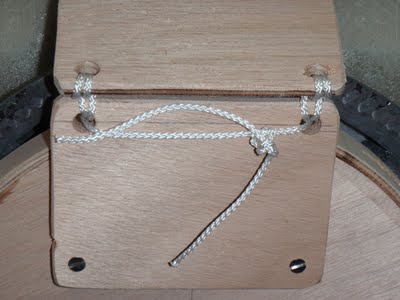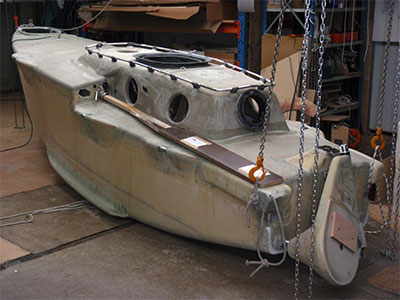
click on the pictures to make them bigger
The deckhouse is now attatched and work is progressing.
ALWAYS SNUG AND WARM
POINTS OF ATACHMENT FOR THE GRABRAIL
Above. I start with temporary attaching the grab rail with several wooden pieces screwed into the laminate and a piece of string. When the grab rail is in the desired position I remove half of the temporary pieces and replace them with high density (425 kg per cubic meter divinycell pieces shown to the right of the wood piece)
Below. I the lash with carbon filament unidirectional glass to get it into position. The ends are cowered with 45 degree glass cloth. The I use NM-Epoxy as glue covering it with peal ply to get a nice finish. Then I replace the temporarily wooden pieces with Divinycell and repeat the process wich is time consuming but gives very satisfactory result.
MY BIRTH DAY 22 APRIL 2010
TACK VARE VARATS OUTGRUNDLIGA REGELMÄSSIGHET FYLLER YRVIND ÅR I ÅR PÅ SAMMA DATUM SOM FÖRRA ÅRET, DEN 22 APRIL.
LIKT FÖRRA ÅRET TAR JAG DET SOM FÖREVÄNDNING ATT FÖR PERSONER MED POSITIVT INTRESSE FÖR LÅNGFÄRDSEGLING I SMÅ BÅTAR VISA HUR MITT VERK UNDER DET FÖRFLUTNA ÅRET HAR FORTSKRIDET.
PRESENTER VILL JAG INTE HA, FÖRUTOM EN PIL OCH PILBÅGE AV SAM ATT JAG FISK MED. HAN HAR ARBETAT PÅ DEN TILL OCH FRÅN, MEST FRÅN, UNDER RASTERNA DET SENASTE ÅRET.
DET BJUDS INTE HELLER PÅ SAFT OCH BULLAR ELLER NÅGOT ANNAT JÄTTEGOTT.
PLATS BAUMANSGATAN 4 59353 VÄSTERVIK. TID 16 – 18.
ELECTICITY
The picture shows the first parts of the electrical system. One charger CHAMP III 12v/7A from PRIMEPOWER It is very compact and waterproof, ideal for a little boat.
There is also six 17 amp hours Exide Sonnenschein gel batteries. Gel batteries have a better cycle life, they can be cycled deeper and more times than Agm batteries. Agm batteries can are better for starting engines but on board there is no engine.
THE FORWARD PUMP
Forward of the forward bulkhead I have now installed a pump, manual of course. I do not expect a leak there, but when for example I am beating into the south east trades at the equator it can for a Swede be uncomfortable hot with hatches closed. Now I can keep the forward hatch open and now and then at ease pump out any spray water.
At the bottom of the fore hatch is a 16 mm stainless pipe in form of a triangle. To it I can tie down anchors and other stuff to keep them in their place. This is important.
To prevent water enter the back way I use a valve. Most marine hardware comes in King Size therefore I remade the handle to a smaller one. Also before the valve only closed one way, the wrong way to the left, now I can close it to the right.
Below the original handle and the new one.
SOME DETAILS
The above picture looks afoul, but the results are nice. Its a styrofoam mold covered with packing tape. Then I glassfibre it and get when done I get a nice detail.
Here is a mock up for the fore hatch to see how big an anchor I can stove.
The screw holds down the back window which can be opened in nice warm weather. The nut is bronze which will be glassed in with epoxy.
More later.
YRVINDS YULOH
The picture below shows the essential yuloh geometry. There are three points of importance. The centre of effort or pressure on the oarblade. The fulcrum and the point were the rope is attached. If you draw a straight line betwwen the centre of effort and the point were the rope is attached the fulcrum shall be a inch or two above that line to keep the thing in balance. Exactly how much is depends on personal preference.
The curvature of the traditional yuloh fixes these three points. On my boat it is not possible to have a curved yuloh as I will store part of my yuloh belov the fore deck in a carbon fibre tube. My yuloh is therefore straight.
To get the essential geometry I have added a removable piece at right angle to the shaft. At the end of that is the attachment point. By varying the length I can adjust the balance. That solves the problem of stowing the oar. It is also very convenient because I can use a straight pipe as oar shaft.
An other thing. Some people like to have the rope doing the twisting of the oar blade at each stroke. I do not agree, neither do the Japanese scullers. They have a technique that differs from the. They have a small handle at right angle to the oar shaft a bit like wrench to twist the blade to the desired angle. In that way you have control and can use the oar blade as an variable pitch propeller. Going against strong winds you use little twist and get much power but the boat mows slow. In calm weather you use much twist and the boat goes faster.
The yuloh traditionally uses a ball and socket at the fulcrum. It is simple to make but a universal joint like mine shown below has several advantages. As a yuloh replaces an engine and I use it a lot I do think it is worth to spend time and money on a better fitting. First the oar cannot jump out of the socket. Second it enables one to scull in reverse and row the stern around. This is very convenient when one maneuvers in tight places. And I do like to get into tricky places to discover interesting things.
SPARS – A PLACE FOR EVERYTHING AND EVERYTHING ON ITS PLACE
CLICK ON THE PICTURES TO MAKE THEM BIGGER
To make the rig adaptable to every wind condition she carries plenty of spars: one topp mast, two light wind booms, two hard wind booms one sprit and one big yuloh to be used when there is no wind. If I had them on deck there would be no place for things like solar panels. I carry them below deck in carbon tubes. The picture below shows the holes where the spars will enter.
This arrangement has the advantages of lowering the center of gravity and reducinging wind resistance. The spars and the mast are easily accessible from the main hatch. I dont have to go on deck to adapt the rig.
The picture below shows the spars in the main cabin, the bed room. The two vertical struts support the deck beam.
The forward ends of the tubes drain overboard. Here I am building up a support of aluminum netting for the glass fiber which will connec the tubes to the drains.
A CHEAP LIGHT HINGE FOR ANGULAR AND LINJEAR MOVENENTS
The hinge is for the aft opening window in the deckhouse. Below is a picture of how I made a mock up of the window.
Below the window mock up is in place in the open position.
Below the window mock up is in place in its closed position.
Below is a close up of the hinge which makes possible angular and linear movements. It is important to have a linear movement in a window when you clamp it down. Ordinary hinges, in my opinion is no good. Still they are used by nearly every one. The reason why the are not always leak proof is you can only clamp down one side of the window, the side opposite to the hinge.
The thousand old trick of making a hinge of a rope threaded in a eight figure gives enough play to move the windows edge deep into the gasket. Making it non leaking in all conditions.

